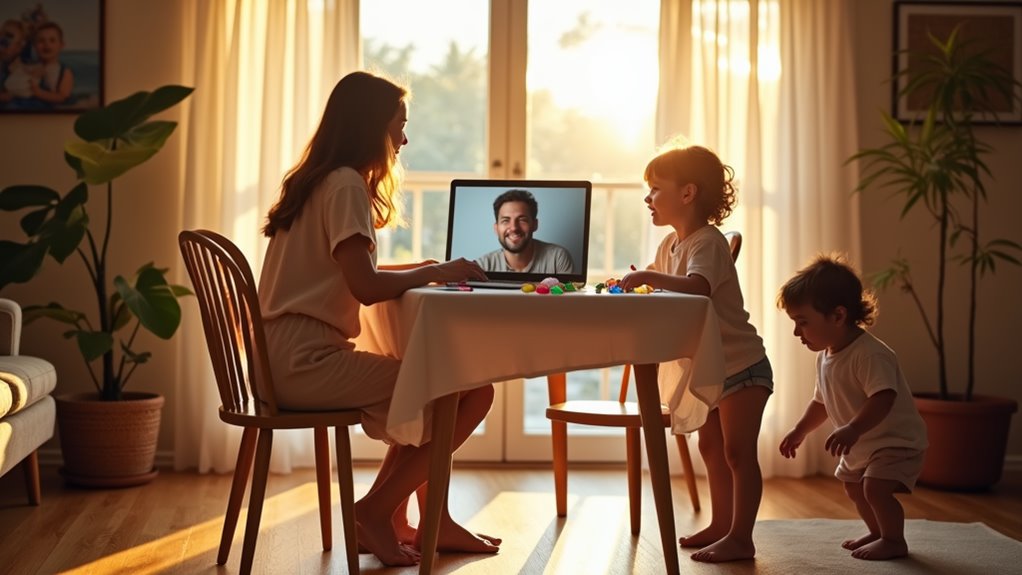To encourage open dialogue with your child, start by creating a safe space where they feel comfy sharing their thoughts. You can practice active listening by putting away distractions like your phone, and letting them speak without interrupting. Ask open-ended questions to invite deeper conversations—think less "yes or no," and more "Tell me about your day!" Sharing your own funny or challenging experiences helps them connect and feel at ease. Regular check-ins can also make chats routine and enjoyable. Remember, respect their feelings and privacy, and keep the conversation light-hearted. There's always more to explore in this important area of communication!
Create a Safe Space
Creating a safe space for your child is essential if you want to encourage open dialogue. Imagine a cozy nook where your child feels comfortable sharing their thoughts and feelings without any judgment.
To create this safe haven, start by choosing a time and place where you can talk without interruptions. This could be during a walk, at the dinner table, or even snuggled up on the couch with some popcorn.
Next, make sure to use encouraging words and body language. A warm smile or a nod can go a long way in making your child feel heard. If they know they can express themselves freely, they'll be more likely to open up about what's on their mind.
It's also important to respect their feelings, even if you don't fully understand them. When your child sees that you take their emotions seriously, it builds their trust in you.
Practice Active Listening
Once you've established a safe space, the next step is to practice active listening. This means really paying attention to what your child is saying, not just hearing the words. When they talk, turn off distractions—yes, that means putting down your phone! Look them in the eye, nod, and show that you care about their thoughts.
You might find yourself tempted to jump in with advice or opinions, but hold on! Instead, let them express themselves fully. It's like letting a balloon float before you catch it—let them release all their feelings and ideas. You can use short phrases like, "I see" or "That's interesting" to encourage them to keep going.
Remember, active listening isn't just about words; it's about feelings, too. Pay attention to their tone and body language. If they seem upset, acknowledge that, saying something like, "It sounds like you're feeling sad." This shows them you understand, which can be really comforting.
Finally, when they finish, you can reflect back what you heard. This not only shows you were listening but also helps clarify their feelings. Trust me, they'll appreciate you being all ears!
Use Open-Ended Questions
Using open-ended questions is a powerful way to encourage your child to share more about their thoughts and feelings. Instead of asking yes or no questions, you can spark deeper conversations by asking questions that get them thinking. For instance, instead of saying, "Did you have fun at school today?" try asking, "What was the most interesting thing that happened at school today?" This invites your child to share their experiences in a more detailed way.
Open-ended questions can help you learn about your child's opinions and feelings. You might ask, "How do you feel about your new friend?" or "What do you think about the movie we watched?" These questions let them express themselves fully rather than just agreeing or disagreeing.
Sometimes, your child might need a little encouragement to open up. If they seem hesitant, you can gently prompt them by saying, "I'd love to hear more about that!"
Share Your Own Experiences
While it's important to encourage your child to share their thoughts, don't forget to share your own experiences too. Kids love hearing about your adventures, even if they seem boring to you! When you share stories from your childhood or recent events, you create a sense of connection. It shows them that everyone has ups and downs, and it's totally okay to talk about them.
For example, maybe you once faced a tough decision about a friend or a sport. By sharing that story, you can show your child how you handled it. They might feel inspired to share their own challenges. Remember, your experiences don't have to be dramatic. A funny moment from a family vacation can spark laughter and open up a great conversation.
Also, be honest about your feelings. If you felt nervous or excited, let them in on that too. It helps your child understand that emotions are normal.
Plus, your stories can teach valuable lessons without sounding like a lecture. So next time you chat, sprinkle in a few of your own tales. It'll make the conversation richer and help your child feel more comfortable opening up!
Be Mindful of Body Language
Sharing your experiences is a great way to foster open communication, but don't underestimate the power of nonverbal cues. Your body language speaks volumes, even when your mouth is closed.
Think about it—when you cross your arms or look away, your child might feel like you're not really listening. Instead, try to face them, keep your arms relaxed, and maintain eye contact. It shows you're interested in what they've to say.
Also, pay attention to your facial expressions. A warm smile can make your child feel safe and loved, while a furrowed brow might signal disapproval or worry.
If you're feeling stressed, they might pick up on that too, so take a deep breath and relax your shoulders before diving into a chat.
Establish Regular Check-Ins
Regular check-ins can create a consistent space for open dialogue with your child, ensuring they feel heard and supported. Setting aside time each week—like Sunday afternoons or before bedtime—can help. It doesn't have to be long; even 15 minutes can work wonders! You might ask about their week or what they enjoyed most. This shows you care and value their thoughts.
You can make it fun, too! Maybe grab a snack or cozy up in a favorite spot. Keep the mood light, so they don't feel pressured to share everything all at once. If your child seems shy or hesitant, you could start with easy questions, like, "What's the funniest thing that happened this week?" This helps break the ice.
Remember to listen actively. Nod, smile, and respond to what they say. Your reactions can encourage them to open up even more. If they seem stuck, you might share something about your week first. It shows vulnerability and creates a safe space.
Regular check-ins not only strengthen your bond but also help your child feel more comfortable in sharing their thoughts and feelings with you. Plus, it's a great excuse to spend time together!
Encourage Emotional Expression
Encouraging emotional expression is essential for your child's development and well-being. When kids learn to share their feelings, they build strong connections with you and others. So, create a safe space where they can talk about their emotions without fear of judgment. Ask open-ended questions like, "How did that make you feel?" This invites them to express themselves more freely.
Sometimes, kids might struggle to find the right words. In those moments, you can introduce fun tools, like emotion charts or even emojis! These can help them identify their feelings, making it easier to open up. Remember, it's perfectly okay for your child to feel upset or angry. Let them know that all emotions are valid, just like toppings on a pizza—every one of them adds flavor!
Also, share your own feelings. When you talk about what you're experiencing, it shows your child that it's normal to express emotions. Plus, it can spark lively discussions!
Encourage them to express not just the good stuff, but the tough feelings too. This way, they'll know you're there to listen, and they'll feel more comfortable sharing their thoughts with you.
Respect Their Privacy
Respecting your child's privacy is essential for building trust and fostering independence. Everyone deserves their own space, including kids! When you allow your child to have some privacy, you're showing them that you respect their feelings and thoughts. This helps them feel more comfortable opening up to you about important stuff.
Think about it: if your child knows you're not going to snoop through their things or read their messages, they'll be more likely to share their worries or joys with you. It's like saying, "Hey, I trust you!"
Plus, it gives them a sense of control over their own life.
Of course, it's important to balance privacy with safety. You can encourage them to be open while reminding them that you're always there to guide them, like a superhero ready to swoop in when needed.
Set clear boundaries together, so they know what's okay and what's not.





